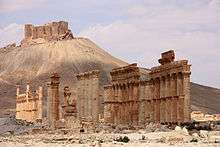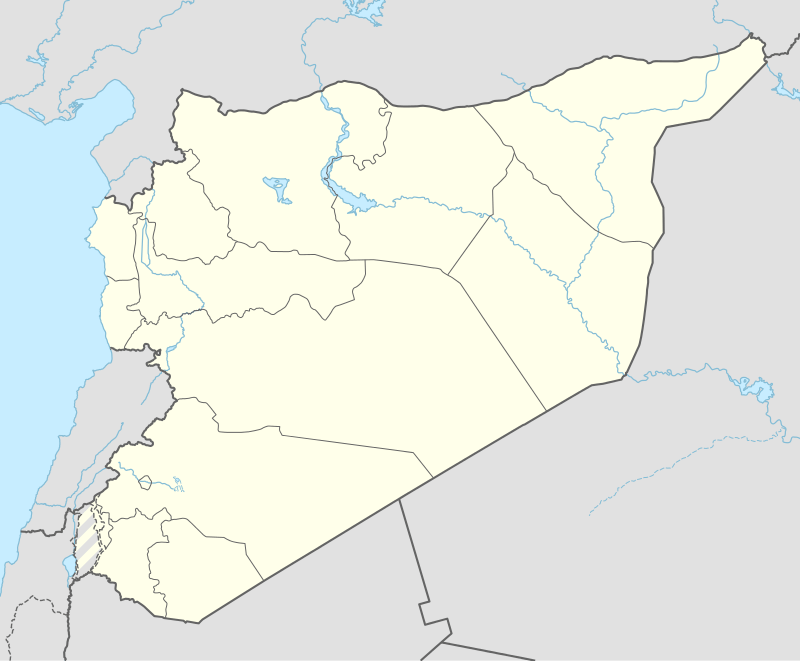Camp of Diocletian
The Camp of Diocletian was a Roman military complex, or castra, built in the ancient city of Palmyra in the Syrian Desert. The complex was built under the Roman Emperor Diocletian in the late third-century CE and served as the military headquarters for the Legio I Illyricorum.[1]
 Remains of the Camp of Diocletian (foreground) | |
 Shown within Syria | |
| Location | Palmyra, Syria |
|---|---|
| Coordinates | 34.5548°N 38.2610°E |
| Type | Military camp |
| Area | 4 hectares (9.9 acres) |
| History | |
| Periods | Roman |
| Site notes | |
| Condition | ruins |
| Ownership | Public |
| Public access | Inaccessible (in a war zone) |
| Type | Cultural |
| Criteria | i, ii, iv |
| Designated | 1980 (4th session) |
| Part of | Site of Palmyra |
| Reference no. | 23 |
| State Party | |
| Region | Arab States |
| Endangered | 2013–present |
Background
During the Crisis of the Third Century, Palmyra broke away from Rome to form the short-lived Palmyrene Empire. The city was recaptured by Aurelian in 272 and, following another unsuccessful rebellion, it was sacked by the Romans in 273.[2]
Following the Roman reconquest, the city was re-fortified with a new set of city walls enclosing a much smaller area.[3] It lost its former importance as a semi-independent trading centre, instead becoming a key military outpost.[4] This is reflected in Palmyra's virtual disappearance from the historical literature; it is listed in the Notitia Dignitatum, a late-4th century record of imperial offices, merely as the base of the Legio I Illyricorum.[5]
Description of the site
The area known today as the Camp of Diocletian was a group of buildings that spanned an area of 4 hectares (9.9 acres) in an enclosure in the western end of the city.[1] It was built on a hill separated from the town proper by a small wall. The hill was located at the far end of the city's Grand Colonnade from the Temple of Bel. The complex was laid out around two colonnaded streets, the via praetoria and the via principalis, that intersected at right angles at a tetrapylon. The via praetoria axis started at the Praetorian Gate and led to the top of the hill where the principia, or the military headquarters, was built. Within the principia, and located at the highest point in the complex was the so-called "temple of the standards," where the legion's standards were probably kept.[3]
The complex may also have included barracks rooms for the soldiers,[1] though it is unclear whether the Roman forces in Palmyra were actually quartered there. They may alternatively have lodged in the city while the "camp" may have functioned as legionary headquarters.[3] The area also enveloped the pre–existing Temple of Allat.[3] The overall design of the site is similar to that of a contemporary camp at Luxor in Egypt and also has similarities with the palace at Antioch and Diocletian's Palace in Split – a sign of how militarised Roman architecture had become in the unsettled climate of the late 3rd century.[5]
The "camp" was designed and built between 293 and 305 CE. An inscription discovered at the temple of the standards proclaims:
- [Reparato]res orbi sui et propagatores generis humani dd. pp. Diocletianus [ ] [invictis]simi impp. et Constantius et Maximianus nobb. Caess. castra feliciter condiderunt [curam age]nte Sossiano Hieroclete v[ir] p[erfectissimus], praess. provinciae, d[evoto] n[umini] m[aiestati]q[ue] eorum.[6]
- The repairers of their world and propagators of the human race, our lords Diocletian and [ ], the most unconquered emperors, and Constantius [Chlorus] and Maximianus [Galerius], the most noble Caesars, have successfully founded the camp [castra], under the care of Sossianus Hierocles, the most perfect man, governor [praeses] of the province, devoted to their numen and maiestas.
The second name after Diocletian's was erased from the inscription but is probably that of his co-emperor Maximian,[1] who was subjected to damnatio memoriae by Constantine I, under which his name was erased from public inscriptions and images of him were destroyed.[7] The other co-emperors mentioned in the inscription are Constantius Chlorus and Galerius.
It is not clear whether the term castra (conventionally translated as "camp") referred exclusively to the Camp of Diocletian. The wall that separated the military buildings from the civilian settlement at Palmyra was clearly only symbolic and there would have been relatively free movement between the camp and the rest of the city. It is possible that the whole city may have been regarded as a castrum, in the wider sense of a fortified place rather than just the much smaller area of the camp.[1]
Excavations
The site has been excavated by a Polish archaeological team from the University of Warsaw. The excavations, led by Dr. Kazimierz Michalowski, unearthed several structures believed to be guard rooms, staircases and side entrances to the compound. The works also determined that the via praetoria colonnade is a remnant of older structures and probably pre-dates the construction of the camp by a century. It also uncovered the layer of occupation preceding the camp which included a residential quarter and funerary artefacts dating to the first-century CE.[8] Furthermore, the excavations discovered several additions dating to the Byzantine period,[9] including a coin and jewelry hoard.[8]
Occupation by ISIL
The extremist Islamic State of Iraq and the Levant (ISIL) group occupied Palmyra between May 2015 and March 2016. Parts of the ancient city were damaged or destroyed by ISIL, and the Russian television network RT claimed that the Camp of Diocletian had been among the areas affected by the ISIL occupation. However, DigitalGlobe satellite imagery from the end of March 2016 showed that there was no visible change to the status of the area.[10]
References
| Wikimedia Commons has media related to Camp of Diocletian. |
Citations
- Pollard, 2000, p. 298.
- Drinkwater, 2005, p. 52
- Millar, 1993, p. 182.
- Lee, p. 269
- Ward-Perkins, 1995, p. 361
- Millar, 2006, p. 227
- Barnes, 1981, p. 41
- Ochsenschlager, 1968, p. 229.
- Kennedy, 2006, p. 171.
- "Special Report: The Recapture of Palmyra". American Schools of Oriental Research. March 2016. Retrieved 21 September 2016.
Bibliography
- Drinkwater, John (2005). "Maximian to Diocletian". In Bowman, Alan; Cameron, Averil; Garnsey, Peter (eds.). The Cambridge Ancient History: Volume 12, The Crisis of Empire, AD 193-337. Cambridge University Press. ISBN 9780521301992.
- Kennedy, Hugh N. (2006). The Byzantine And Early Islamic Near East. Ashgate Publishing. ISBN 9780754659099.
- Lee, Jess (2010). Syria Handbook. Footprint Travel Guides. ISBN 9781907263033.
- Millar, Fergus G. (1993). The Roman Near East: 31 BC – AD 337. Harvard University Press. ISBN 9780674778863.
- Millar, Fergus (2006). Rome, the Greek World, and the East: The Greek world, the Jews, and the East. University of North Carolina Press. ISBN 9780807830307.
- Ochsenschlager, Edward L. (1968). "Classical Excavations in the Southeastern Mediterranean". The Classical World. Classical Association of the Atlantic States. 61 (6): 224–230. doi:10.2307/4346468.
- Pollard, Nigel (2000). Soldiers, Cities, & Civilians in Roman Syria. University of Michigan Press. ISBN 9780472111558.
- Ward-Perkins, John (1994). Roman Imperial Architecture. Yale University Press. ISBN 9780300052923.